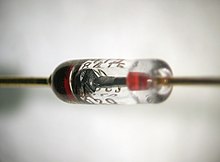In electronics, a diode is a two- terminal electronic component that conducts electric current in only one direction. The term usually refers to a semiconductor diode, the most common type today, which is a crystal of semiconductor connected to two electrical terminals, a p.n junction. A vacuum tube diode, now little used, is a vaccume tube with two electrodes; a plate and a cathode
The most common function of a diode is to allow an electric current in one direction (called the diode's forward direction) while blocking current in the opposite direction (the reverse direction). Thus, the diode can be thought of as an electronic version of a check valve. This unidirectional behavior is called rectification , and is used to convert alternating to direct current, and extract modulation from radio signals in radio receivers.
However, diodes can have more complicated behavior than this simple on-off action, due to their complex non linear electrical characteristics, which can be tailored by varying the construction of their pn junction. These are exploited in special purpose diodes that perform many different functions. Diodes are used to regulate voltage zener diode, electronically tune radio and TV receivers (varactor diode), generate radio frequency diode tunnel diode, and produce light (light emitting diode)









No comments:
Post a Comment